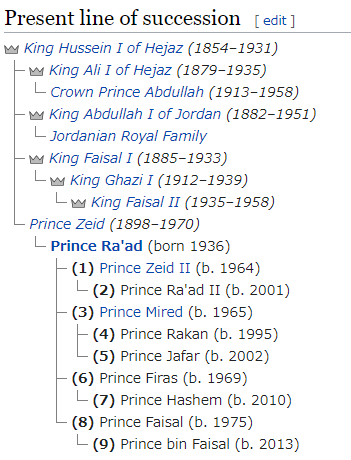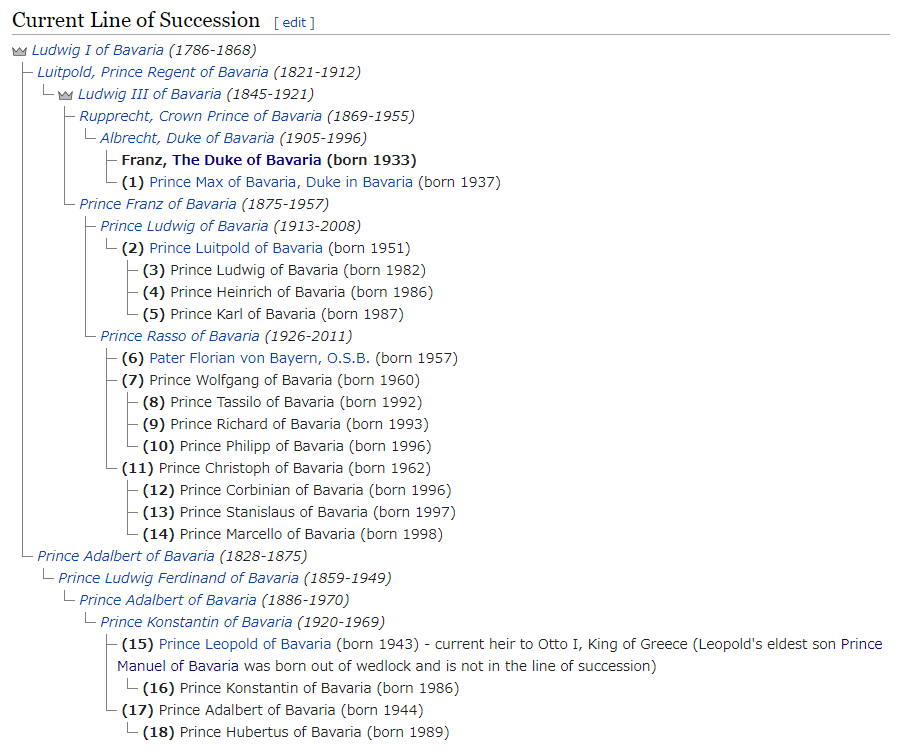In Wikipedia, this article’s name is(was) Head of the House of Aisin Gioro.
(Also added from Head of the former Chinese imperial clan.)
note:
As of July 2020.
See also:
Line of succession to the former Monarchical throne and others : From (deleted) Wikipedia’s articles.
The House of Aisin Gioro established two dynastic regimes in Chinese history: the Later Jin (1616–1636) and the Qing dynasty (1636–1912). A Chinese emperor would pick one of his many sons, or another relative, to succeed him. During the Qing dynasty, a succession edict was hidden in the palace and read upon the death of the emperor.
After Puyi, China’s last emperor, was ousted in 1912, the country was declared a republic. Puyi was emperor of Manchukuo, now northeastern China, in 1934–1945. He died without issue in 1967. His brother Prince Pujie was next in line under a 1937 succession law, the most recently published agreed upon succession rule. Stories published in the Chicago Times and The New York Times acknowledge Pujie as heir of Puyi.
Pujie died in 1994. He is survived by a daughter, Princess Husheng, who was born in 1941. However, the law restricts succession to males. Several news stories have suggested that Jin Yuzhang, a nephew of Puyi and Pujie, is the current family head.
Present line of succession
- Min-ning, the Daoguang Emperor of China (1782-1850)
- Yizhu, the Xianfeng Emperor of China (1831-1861)
- Zaichun, the Tongzhi Emperor of China (1856-1875)
- Yichong (1831-1889[6])
- Zailian (1854-1917[7])
- Pucheng (1873-1932[8])
- Yuyan (1918-1999[9])
- (?) Hengzhen (b. 1944[10])
- Yixuan, 1st Prince Chun (1840-1891)
- Zaitian, the Guangxu Emperor of China (1871-1908)
- Zaifeng, The Prince-Regent (1883-1951)
- Puyi, the Xuantong Emperor of China, Emperor of Manchukuo (1906-1967)
- Pujie, Head of the House of Aisin-Gioro (1907-1994)
- Puren, Head of the House of Aisin-Gioro (1918-2015)
- Jin Yuzhang, Head of the House of Aisin-Gioro (born 1942)[5]
- (1) Jin Yuquan (金毓峑, born 1946)[11]
- (2) Jin Yulan (金毓岚, born 1948)[12]
- Zaixun, Prince Rui (1885-1949)
- Pugong (1904-1960s)
- (3) Huang Shixiang (born 1934)

The Manchukuo order of succession provided for inheritance by Puyi’s brothers and their male descendants. However, none of Puyi’s three living nephews has any male offspring, so under a strict interpretation the “Manchukuo branch” will go extinct upon the deaths of the current generation.
However, if allowing for inheritance by primogeniture via emperors prior to Puyi, Peking Opera singer Huang Shixiang would also join the line of succession. It is unclear if he has any sons, and therefore the exact ranking of rival pretenders like Hengzhen is also unknown.
Alternative proposals
In The Empty Throne (1993), Tony Scotland tells how he found Prince Yuyan, who lived in a mud floor hovel near the imperial palace. Yuyan, a distant cousin of Puyi, told Scotland that the former emperor made him heir to the throne in a ceremony performed while they were imprisoned in Russia together in 1950. This claim is not supported by any official document, although it was customary in the Qing dynasty that an emperor name his successor in a will or edict. Puyi’s autobiography confirms merely that the idea was discussed. Yuyan died in 1997. His eldest son is Prince Hengzhen, who was born in 1944. There is no indication that Yuyan designated him heir to the throne, or that he claims this status.
The Yuyan-Hengzhen lineage descends from prince Yicong, fifth son of the Daoguang Emperor. During the succession of 1875, Yicong’s descendants were passed over in favor of those of the Daoguang Emperor’s seventh son Yuxuan, who became father of the Guangxu Emperor, grandfather of the Xuantong Emperor Puyi, and great-grandfather of the pretender Jin Yuzhang. It could therefore be argued that Hengzhen, under a principle of strict primogeniture, has a stronger claim to the throne than Jin Yuzhang. However, imperial China did not consistently practice primogeniture. The emperor could in principle appoint any male relative he wanted as his heir. A hypothetical adoption of Yuyan by Puyi would in any event have “returned” the throne to the more senior lineage. Regardless of which branch has the better claim, the shortage of male heirs in Jin Yuzhang’s branch could eventually see the pretendership return to Hengzhen’s branch through the natural extinction of the competing branch.
During the 1911 Revolution some minorities suggested that the Manchu emperor be replaced by an ethnic Chinese. Both Duke Yansheng, a descendant of Confucius, and the Marquis of Extended Grace, a descendant of the imperial family of the Ming dynasty, were proposed and rejected.
Empire of China (1915–1916)
In 1915, Yuan Shikai attempted to reinstate monarchy in China; he proclaimed the Empire of China with himself as the Hongxian Emperor. However, due to massive objection across provinces of China, Yuan needed to withdraw his attempt and died on June 6, 1916 as the President of the Republic of China. During the preparation of the empire, Yuan planned to make Yuan Keding, his eldest son, the crown prince of the Empire of China. Yuan Keding still retained the courtesy of a “crown prince” for decades later even though the empire never existed.
Yuan Keding had a son and two daughters with modern descendants, although he had the other 31 siblings:
- Hongxian Emperor of China (1859-1916)
- Yuan Keding (1878-1958)
- Yuan Jiarong (袁家融, 1904-1996)
- Yuan Monglin (袁萌臨, 1933-2009)




